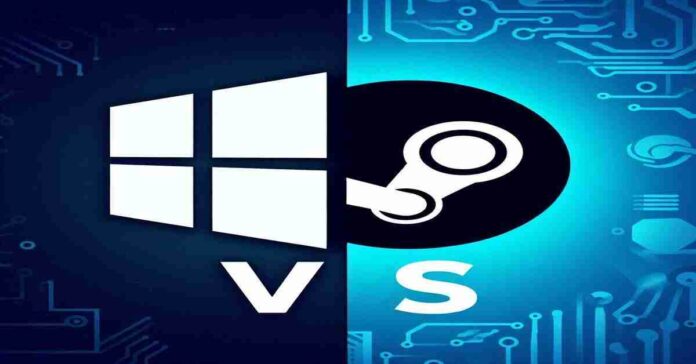Beyond Windows: How SteamOS is Shaking Up Handheld & Desktop PC Gaming. It’s June 2025, and while many of us are looking forward to summer, the tech world has just been shaken up by some pretty significant revelations. Specifically, PC gamers might be rethinking their operating system choices, and Nvidia seems to be in a bit of a pickle. Let’s dive into the latest from the world of tech!
The SteamOS Advantage:
Better Gaming Performance and Battery Life? For years, Windows has been the undisputed king of PC gaming operating systems, primarily due to its broad compatibility. But what if there was a better, faster option? A recent video by Dave2D put SteamOS to the test on the Lenovo Legion Go S handheld (now $130 cheaper!), and the results were surprising.
Games reportedly ran 5% to 15% faster on SteamOS. Even more crucially for handheld devices, battery life received a significant boost. The overall OS experience was also smoother, with sleep functions working as intended and none of the mysterious battery drain issues often seen with Windows handhelds and laptops.
SteamOS version 3.7:
SteamOS version 3.7officially rolled out last week, supporting not just the Steam Deck and Legion Go, but also other AMD-powered handhelds (Ryzen Z1 and Z2 SOCs). Interestingly, it can even be installed on a desktop PC with an AMD GPU, as demonstrated by Jove’s Gaming Lounge.
While Valve and Jove both emphasize that SteamOS isn’t a direct Windows or Linux replacement (basic PC functions can be tricky, and Nvidia GPU compatibility is currently a no-go), early tests show promising results in games like Tomb Raider, Black Myth Wukong, and Forza Horizon 4. However, performance was worse in Counter-Strike 2, indicating it’s not a universal win yet.
If Valve continues to develop SteamOS and broaden hardware compatibility, many gamers might seriously consider ditching Windows for the promise of free performance. Microsoft seems to have taken notice, too, with rumors of the Xbox handheld being delayed to shift focus to Windows 11 optimization for third-party gaming PCs. The competition is heating up!
Nvidia’s RTX 5060:
A Disappointing Launch Nvidia’s RTX 5060 launch has been controversial, with accusations of handpicked reviews and a lack of pre-launch drivers. Why all the secrecy? Independent reviews are now trickling in, shedding light on the situation.
Hardware Unboxed’s tests show the RTX 5060 outperforming the RTX 3060 Ti and RX 6700 XT at 1080p, but it falls short of the RTX 4060 Ti and RTX 3070. The major sticking point, however, is the 8GB VRAM limitation. At 1440p, cards with more memory, like the 12GB Arc B580 or Radeon 6700 XT, gain significant ground because they simply don’t run out of memory as often.
Jay’s review echoed similar results, showing a passable 10-15% performance improvement over the RTX 4060 until the memory limit is hit, leading to severe performance drops. While the 5060 might be “functional” for esports titles or games like Counter-Strike and Fortnite, Daniel Owens’ review highlighted major problems with 1% lows (manifesting as stutters) in eight recent titles tested at 1440p, and even seven of those struggled at 1080p.
It seems the RTX 5060 struggles to keep up with current PC gaming titles without significant compromises. Despite the criticism, Nvidia’s Q1 2026 financial results show them stronger than ever, with overall revenue up 69% year-over-year, largely driven by their data center business and the “sweet AI money.” GeForce revenue also saw a healthy 42% increase. This suggests that gamer recommendations against buying 50 series GPUs haven’t significantly impacted their overall sales.
Intel’s Arc Future and AI’s Storage Appetite Despite not showcasing a “Battle Mage” B770 GPU at Computex, rumors persist that Intel is still working on it. Leaked device IDs in a Linux Mesa graphics driver update hint at new “BMG” (Battle Mage) cards, suggesting a Q4 release. This offers a glimmer of hope for gamers looking for more GPU options, especially after the B580 saw real-world pricing increase significantly above MSRP.
On the CPU front, it appears Intel’s LGA1851 platform might see an “Arrow Lake” refresh before being replaced, continuing Intel’s pattern of shorter socket lifespans.
Finally, a growing concern: AI’s insatiable appetite for storage. Data centers are rapidly filling with AI-generated data. Seagate reports that humans produce 1-2 zettabytes of storage annually, which is a fraction of projected data creation by AI. This massive demand could lead to skyrocketing storage prices in the coming year, as the “value of data has never been greater,” according to Seagate’s VP of Customer Engineering. Prepare for your hard drives and SSDs to get more expensive!
What are your thoughts on these developments? Is SteamOS the future of PC gaming, or will Windows fight back? And are you prepared for potentially higher storage prices? Let us know in the comments!



